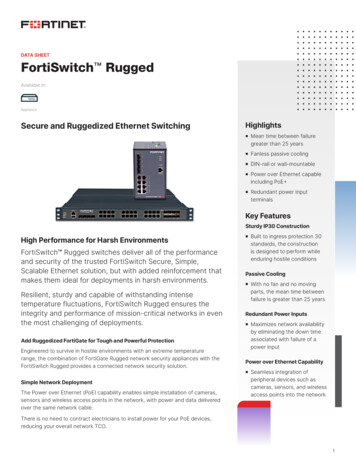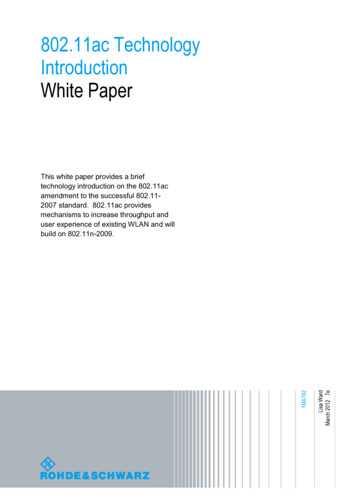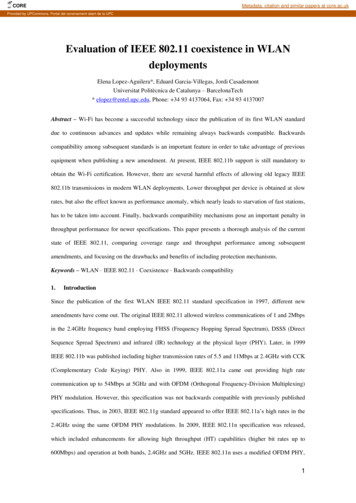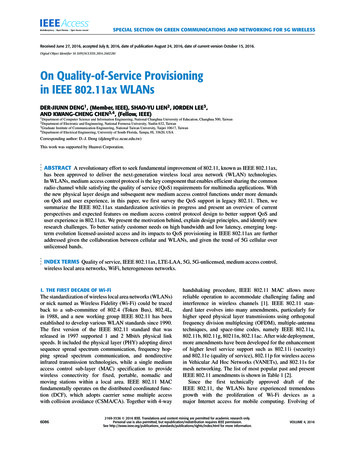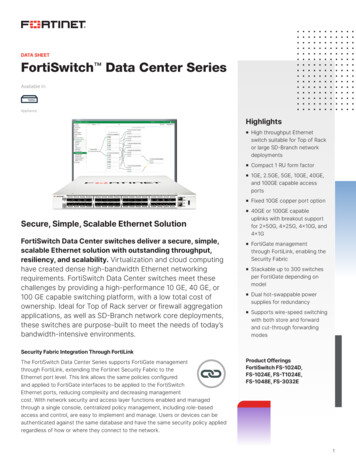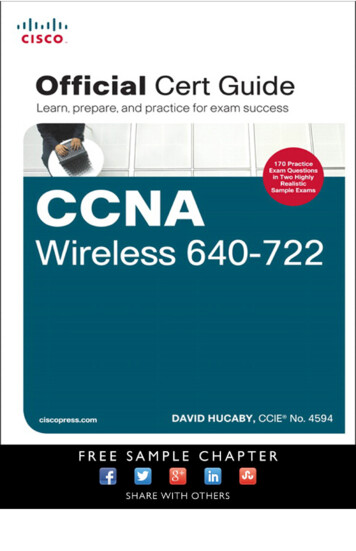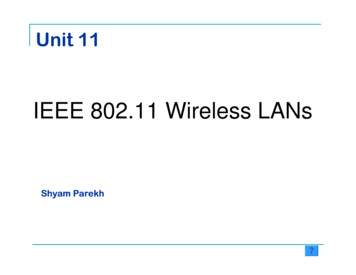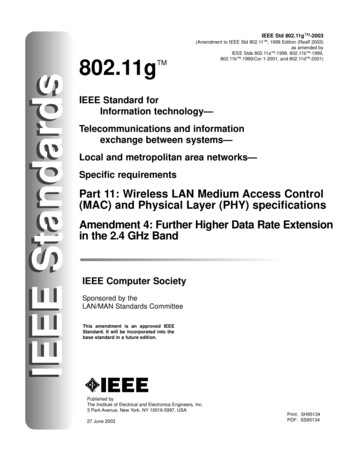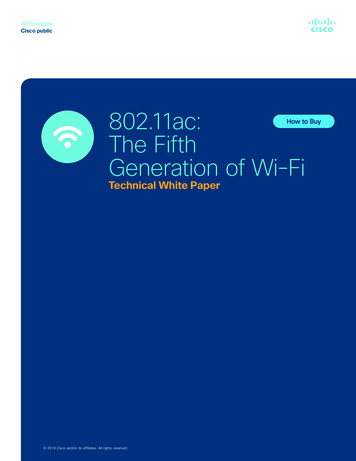
Transcription
White paperCisco public802.11ac:The FifthGeneration of Wi-FiTechnical White Paper 2018 Cisco and/or its affiliates. All rights reserved.
White paperCisco publicContents1. Executive summary2. What is 802.11ac?2.1 Drivers for 802.11ac2.2 H ow does 802.11ac goso fast?2.3 H ow do we make802.11ac robust?2.3.1 Technology overview2.3.2 D ifferences between802.11ac and 802.11n2.3.3 S tandards-basedbeamforming2.3.4 R TS/CTS with bandwidthindication2.3.5 All A-MPDUs2.3.6 C hannelization and80 80 MHz2.3.7 Rate at range2.3.8 Regulatory considerations2.3.9 MU-MIMO2.3.10 8 02.11ac projectauthorization request3. H ow does 802.11acaffect me?3.1 Compatibility3.2 R adio resource managementand WIPS effects4. Summary 2018 Cisco and/or its affiliates. All rights reserved.1. Executive summary802.11ac, the emerging standard from the IEEE, is like the movie TheGodfather Part II. It takes something great and makes it even better.802.11ac is a faster and more scalable version of 802.11n. It couples thefreedom of wireless with the capabilities of Gigabit Ethernet.Wireless LAN sites will see significant improvements in the number of clientssupported by an Access Point (AP), a better experience for each client, andmore available bandwidth for a higher number of parallel video streams. Evenwhen the network is not fully loaded, users see a benefit: their file downloadsand email sync happen at low lag gigabit speeds. Also, device battery life isextended, since the device’s Wi-Fi interface can wake up, exchange datawith its AP, and then revert to dozing that much more quickly.802.11ac achieves its raw speed increase by pushing on three differentdimensions: More channel bonding, increased from a maximum of 40 MHz with 802.11nup to 80 or even 160 MHz (for speed increases of 117 or 333 percent,respectively). Denser modulation, now using 256 Quadrature Amplitude Modulation(QAM), up from 64QAM in 802.11n (for a 33 percent speed burst at shorter,yet still usable, ranges). More Multiple Input, Multiple Output (MIMO). Whereas 802.11n stopped atfour spatial streams, 802.11ac goes all the way to eight (for another 100percent speed increase).The design constraints and economics that kept 802.11n products at one,two, or three spatial streams haven’t changed much for 802.11ac, so wecan expect the same kind of product availability, with first-wave 802.11acproducts built around 80 MHz and delivering up to 433 Mbps (low end), 867Mbps (mid-tier), or 1300 Mbps (high end) at the physical layer. Secondwave products, or 802.11ac Wave 2 as they are sometimes referred to,support more channel bonding and spatial streams, with plausible productconfigurations operating at up to 3.47 Gbps.802.11ac is a 5-GHz-only technology, so dual-band APs and clients willcontinue to use 802.11n at 2.4 GHz. However, 802.11ac clients operate inthe less crowded 5-GHz band.
White paperCisco publicSecond-wave or Wave 2 products also come with anew technology, multiuser MIMO (MU-MIMO). Whereas802.11n is like an Ethernet hub that can transfer only asingle frame at a time to all its ports, MU-MIMO allowsan AP to send multiple frames to multiple clients atthe same time over the same frequency spectrum.That’s right: with multiple antennas and smarts, an APcan behave like a wireless switch. There are technicalconstraints, and so MU-MIMO is particularly well suitedto Bring-Your-Own-Device (BYOD) situations in whichdevices such as smartphones and tablets have only asingle antenna.a remarkable level of performance. If you still have anolder standard like 802.11n deployed today, upgradingto the latest 802.11ac Wave 2 technology will providebetter performance for bandwidth-intensive applicationslike streaming video and collaboration. The newertechnology will also address a common issue thatmost networks are seeing today, providing consistentperformance in the face of higher density or morewireless clients accessing the network. Cisco offers abroad portfolio of products that support 802.11ac Wave2, as well as the right innovation and features designedfor a variety of different network sizes and needs.802.11ac-enabled products are the culmination ofefforts at the IEEE and Wi-Fi Alliance pipelines. IEEE802.11ac delivered an approved Draft 2.0 amendmentin January 2012 and a refined Draft 3.0 in May 2012,with final ratification in December 2013. In parallel, theWi-Fi Alliance adopted an early but very stable andmature IEEE draft, namely Draft 3.0, and used that asthe baseline for an interoperability certification of firstwave products in mid-2013. The Wi-Fi Alliance split its802.11ac certification into two parts, in order to includetesting of the more advanced features. This secondwave certification includes features that were not in theearlier certification (Wave 1). These features includechannel bonding up to 160 MHz, four spatial streams,and MU-MIMO. Overall, this arrangement closely followshow 802.11n was rolled out, with 802.11ac Wave 1coming out first and Wave 2 products being releasedabout 18 months later.When it comes to interoperability with older standards,802.11ac will have a few effects on existing 802.11a/ndeployments, even if the deployment is not upgraded to802.11ac immediately: (1) the wider channel bandwidthsof neighboring APs require updates to radio resourcemanagement, or RRM (and in particular the dynamicchannel assignment algorithm), and (2) 802.11a/nWireless Intrusion Protection Systems (WIPS) cancontinue to decode most management frames suchas beacon and probe request/response frames (thatare invariably sent in 802.11a format) but do not havevisibility into data sent in the 802.11ac packet format.Enterprise networks considering an investment ininfrastructure Wi-Fi have the choice to move from anolder technology such as 802.11n while also delivering 2018 Cisco and/or its affiliates. All rights reserved.One thing not to worry about is compatibility. 802.11acis designed in a deep way to coexist efficiently withexisting 802.11a/n devices, with strong carrier sense,a single new preamble that appears to be a valid802.11a preamble to 802.11a/n devices, and extensionsto Request-To-Send/Clear-To-Send (RTS/CTS) tohelp avoid collisions with users operating on slightlydifferent channels.
White paperCisco public2. What is 802.11ac?First, 802.11ac is an evolution of 802.11n. If you want tolearn more about 802.11n, jump to the Appendix. If youare already familiar with the channel bonding, MIMO, andaggregation introduced by 802.11n, and you don’t needa refresher, read on.2.1 Drivers for 802.11ac802.11ac is an evolutionary improvement to 802.11n.One of the goals of 802.11ac is to deliver higher levelsof performance that are commensurate with GigabitEthernet networking: A seemingly “instantaneous” data transfer experience A pipe fat enough that delivering a high Quality ofexperience (QoE) is straightforwardIn the consumer space, the target is multiple channels ofHigh-Definition (HD) content delivered to all areas of thehouse. The enterprise has different challenges: Delivering network with enterprise-class speedsand latencies High-density environments with scores of clients per AP-- This density is exacerbated by the BYOD trend,such that one employee might carry two or eventhree 802.11 devices and have them all consumingnetwork resources at the same time-- The proliferation of wireless IoT devices alsoincreases the density of networks The increased adoption of video streaming, collaborationand other bandwidth-intensive applications802.11ac is about delivering an outstanding experienceto each and every client served by an AP, even underdemanding loads.Meanwhile, 802.11 is integral to a hugely broad rangeof devices, and some of them are highly cost, power,or volume constrained. One antenna is routine for thesedevices, yet 802.11ac must still deliver peak efficiency.The one thing that 802.11ac has in its favor is theevolutionary improvement to silicon technology over thepast half-dozen years: channel bandwidths can be wider,constellations can be denser, and APs can integratemore functionality.Figure 1. How 802.11ac accelerates 802.11nData Bitsper Subcarrier802.11acAP256QAM@r5/664QAM@r5/648Spatial streams 2018 Cisco and/or its affiliates. All rights reserved.802.11nAP4080160Channelbandwidth(MHz)
White paperCisco public2.2 How does 802.11ac go so fast?Wireless speed is the product of three factors: channel bandwidth, constellation density, and number of spatialstreams. 802.11ac pushes hard on the boundaries on each of these, as shown in Figure 1.For the mathematically inclined, the physical layer speed of 802.11ac is calculated according to Table 1. For instance,an 80-MHz transmission sent at 256QAM with three spatial streams and a short guard interval delivers 234 3 5/6 8 bits/3.6 microseconds 1300 Mbps.Table 1. Calculating the speed of 802.11n and 802.11acPHY802.11nor802.11acBandwidth(as number ofdata subcarriers)Numberof spatialstreamsData bits persubcarrierTime perOFDM symbol56 (20 MHz)1 to 4Up to 5/6 log2(64) 53.6microseconds(short guardinterval)XX 108 (40 MHz)802.11aconly234 (80 MHz)PHYdata rate(bps) 4 microseconds(long guardinterval)5 to 8Up to 5/6 log2(256) 6.672 234 (160MHz)Immediately we see that increasing the channelbandwidth to 80 MHz yields 2.16 times faster speeds,and 160 MHz offers a further doubling. Nothing is forfree: it does consume more spectrum, and each timewe’re splitting the same transmit power over twice asmany subcarriers, so the speed doubles, but the rangefor that doubled speed is slightly reduced(for an overall win).Going from 64QAM to 256QAM also helps, by another8/6 1.33 times faster. Being closer together, theconstellation points are more sensitive to noise, so 2018 Cisco and/or its affiliates. All rights reserved.256QAM helps most at shorter range where 64QAMis already reliable. Still, 256QAM doesn’t require morespectrum or more antennas than 64QAM.The speed is directly proportional to the number ofspatial streams. More spatial streams require moreantennas, RF connectors, and RF chains at transmitterand receiver. The antennas should be spaced onethird of a wavelength (3/4 inch) or more apart, andthe additional RF chains consume additional power.This drives many mobile devices to limit the number ofantennas to one, two, or three.
White paperCisco publicCollectively, these three speed increases are significant. As shown in Figure 2 and Table 2, the minimum allowed802.11ac product is 4.4 times faster than the corresponding 802.11n product, and the mid-tier and high-end Wave1 products are nearly 3 times faster, reaching 1.3 Gbps PHY data rates. Actual throughput will be a function of MACefficiency (rarely better than 70 percent) and the capabilities of the devices at each end of the link.Figure 2.Evolution of Cisco APs with 802.11 physical layer 802.11a/gHT802.11nVHTVHT802.11ac 802.11acWave1Wave2*Assuming 160 MHz isAvailable and suitable 2018 Cisco and/or its affiliates. All rights reserved.
White paperCisco publicTable 2.Important data rates of 802.11a, 802.11n, and 802.11ac NominalconfigurationBandwidth(MHz)Numberof spatialstreamsConstellationsize and rateGuardintervalPHY datarate 424Amendment min20164QAMr5/6Long6546Low-end product (2.4GHz only )20164QAMr5/6Short7251Mid-tier product40264QAMr5/6Short300210Max product40364QAMr5/6Short450320Amendment max40464QAMr5/6Short600420Amendment min80164QAMr5/6Long293210Low-end product801256QAMr5/6Short433300Mid-tier product802256QAMr5/6Short867610High-end product803256QAMr5/6Short1300910Amendment max808256QAMr5/6Short34702400Low-end product1601256QAMr5/6Short867610Mid-tier product1602256QAMr5/6Short17301200High-end product1603256QAMr5/6Short26001800Ultra-high-end product 1604256QAMr5/6Short34702400Amendment max8256QAMr5/6Short69304900802.11n802.11ac 80 MHz802.11ac 160 MHz160*Assuming a 70 percent efficient MAC, except for 802.11a, which lacks aggregation. Assuming that 40 MHz is not available due to the presence of other APs. 2018 Cisco and/or its affiliates. All rights reserved.
White paperCisco public2.3 How do we make 802.11ac robust?The sticker on the box that shows the maximum datarate doesn’t help us much in the real world, wheredevices have to contend with interference from non802.11 devices, preexisting APs that might only use 20or 40 MHz, multipath fading, few antennas on mobiledevices, weak signals at range, and so forth. Whatmakes the raw speed of 802.11ac so valuable are theextensions that help to deliver reliable throughput underrealistic conditions.2.3.1 Technology overviewBy design, 802.11ac is intended to operate only in the5-GHz band, as shown in Table 3. This avoids much ofthe interference at 2.4 GHz, including Bluetooth headsetsand microwave ovens, and provides a strong incentivefor users to upgrade their mobile devices (and hotspotAPs) to dual-band capability so that the 5-GHz band ismore universally usable. This choice also streamlines theIEEE process by avoiding the possibility of contentionbetween 802.11 and 802.15 proponents. And there isbarely 80 MHz of bandwidth at 2.4 GHz anyway.As we’ve already seen, 802.11 introduces higher-ordermodulation, up to 256QAM; additional channel bonding,up to 80 or 160 MHz; and more spatial streams, up toeight. There is an alternative way to send a 160-MHzsignal, known as “80 80” MHz, discussed later(see Section 2.3.6).802.11ac continues some of the more valuable featuresof 802.11n, including the option of a short guard interval(for a 10 percent bump in speed) and an incrementallybetter rate at range using the advanced low-densityparity check (LDPC) forward error-correcting codes.These LDPC codes are designed to be an evolutionaryextension of the 802.11n LDPC codes, so implementerscan readily extend their current hardware designs. 2018 Cisco and/or its affiliates. All rights reserved.Various Space Time Block Codes (STBCs) are allowedas options, but (1) this list is trimmed from the overrichset defined by 802.11n, and (2) STBC is largely maderedundant by beamforming. 802.11n defined the coreSTBC modes of 2 1 and 4 2 and also 3 2 and 4 3as extension modes, but the extension modes offeredlittle gain for their additional complexity and havenot made it to products. Indeed, only the most basicmode, 2 1, has been certified by the Wi-Fi Alliance.With this experience, 802.11ac defines only the core2 1, 4 2, 6 3, and 8 4 STBC modes, but again only2 1 is expected to make it to products: if you had anAP with four antennas, why would you be satisfiedwith 4 2 STBC when you could - and should - beusing beamforming?What 802.11ac also gets right is to define a singleway of performing channel sounding for beamforming:so-called explicit compressed feedback. Althoughoptional, if an implementer wants to offer the benefits ofstandards-based beamforming, there is no choice but toselect that single mechanism, which can then be testedfor interoperability.Because of the wider channel bandwidths of 802.11ac,it is much more likely that an 80-MHz AP will overlapwith another 20- or 40-MHz AP - and similarly an 80- or160-MHz AP - or even several of them, all potentially ondifferent channels. To enable reliable operation amid thiscomplexity, 802.11ac mandates extensions to the RTS/CTS mechanism, stronger Clear-Channel Assessment(CCA) requirements, and new primary channel selectionrules. See Section 2.3.4.802.11ac also introduces a valuable new technologycalled multiuser MIMO. This is challenging to get right,so it is deferred until the second wave of 802.11acproducts and will likely be optional. More on this later inSection 2.3.9.
White paperCisco publicTable 3.Primary ingredients of 802.11acParameter802.11ac Draft 3.0Wave 1 Wi-Fi Alliancecertification802.11ac (subset ofratified amendment)Potential Wave 2 Wi-FiAlliance certificationSpectrum5 GHz (varied support by regulatory domain; nearly 600MHz in the United States)BandwidthMandatory: 20, 40, and 80MHzModulationMandatory: BPSK, QPSK, 16QAM, 64QAMOptional: 256QAMNumber of spatialstreamsMandatory: 2 (nonmobileAPs*), 1 (others)Mandatory: 2 (nonmobileAPs*), 1 (others)Optional: up to 3 spatialstreamsOptional: up to 4 spatialstreamsForward error correction802.11ac completeamendment 6 GHz, excluding 2.4 GHzMandatory: 20, 40, and 80 MHzOptional: 160 and 80 80 MHzMandatory: 1Optional: 2 to 8Mandatory: BCCOptional: LDPCSTBCOptional: 2 1 AP to clientShort guard intervalOptionalSounding (a singleinteroperable protocol)OptionalCTS in response toRTS with bandwidthindicationMandatoryRTS with bandwidthindicationOptionalAggregationMandatory: TX and RX ofA-MPDUMandatory: TX and RX ofA-MPDUOptional: RX A-MPDU ofA-MSDUOptional: RX A-MPDU ofA-MSDU-OptionalMU-MIMO* Additional requirement introduced by the Wi-Fi Alliance. 2018 Cisco and/or its affiliates. All rights reserved.Optional: 2 1, 4 2, 6 3,8 4A-MDPU, A-MDPU ofA-MSDU
White paperCisco public2.3.2 Differences between 802.11ac and 802.11n802.11ac has avoided the battles of 802.11n andinstead has focused on extending the tremendousadvances made in 802.11n to deliver the next generationof speed and robustness.For instance, 802.11n pioneered aggregation throughthe selective use of A-MPDU, A-MSDU, and A-MPDU ofA MSDU (see the Appendix). 802.11ac actually requiresevery 802.11ac transmission to be sent as an A-MPDUaggregate. This is due in part to the intrinsic efficiencyof A-MPDU, as well as to some other factors(see Section 2.3.5).In a further example, 802.11ac extends the 802.11nchannel access mechanism: virtual carrier sense andbackoff occur on a single 20-MHz primary channel; CCAis then used for the remaining 20-MHz subchannelsimmediately before transmitting on them.Given the power of A-MPDU and the 802.11n channelaccess mechanism, 802.11ac actually didn’t need toinnovate much in the MAC. Indeed, extensions to theRTS/CTS mechanism are the only new mandatoryMAC feature.802.11n does include many options with reduced value,and 802.11ac takes a very pragmatic approach to them.If a “useless” option is used and affects a third-partydevice, 802.11ac typically forbids an 802.11ac device(operating in 802.11ac mode) from using the option. If a“useless” option has not been used in 802.11n productsor affects only the devices that activate the option, thefeature is not updated for 802.11ac but is instead“left to die.”For instance, there is no 802.11ac version of the“802.11n greenfield” preamble format. 802.11ac definesonly one preamble format, which, to legacy 802.11a/ndevices, will look safely like an 802.11a preamblefollowed by a payload with a bad CRC. This means thatlegacy devices won’t try to transmit over the top of the802.11ac transmission, nor will they attempt to send abad payload up the stack.802.11n introduced Reduced Interframe Spacing(RIFS), which reduces overheads between consecutive 2018 Cisco and/or its affiliates. All rights reserved.transmissions, but experience has shown that A-MDPUsolves much the same problem even more efficiently.802.11ac devices operating in 802.11ac mode are notpermitted to transmit RIFS (as of Draft 3.0).802.11n features that are not updated for 802.11ac (orare explicitly forbidden for 802.11ac devices operatingin 802.11ac mode) include all the 802.11n soundingoptions, including extension LTFs, the calibrationprocedure, antenna selection, PCO, L-SIG TXOPprotection, unequal modulation, 4 3 and 3 2 STBCmodes, MCS32, and dual CTS protection. Don’t worry ifyou don’t know these terms; you’ll almost certainly neverneed to understand them.2.3.3 Standards-based beamformingAny device (with multiple antennas) can beamform toany other device at any time. What 802.11ac adds isthe opportunity for the receiver to help the beamformingtransmitter to do a better job of beamforming. Thisis called “sounding,” and it enables the beamformerto precisely steer its transmitted energy toward thereceiver. 802.11ac defines a single, though optional,protocol for one 802.11ac device to sound other802.11ac devices. The protocol selected closely followsthe 802.11n explicit compressed feedback protocol,as follows.A device, typically an AP, sends a “Very High Throughput(VHT) Null Data Packet (NDP) Announcement” frame.Its only purpose is to contain the address of the AP andof the target recipients. The VHT NDP Announcementframe is immediately followed by a “VHT Null DataPacket” (VHT NDP) intended for those target recipients.Each intended recipient measures the RF channel fromthe AP to itself using the preamble of the VHT NDP andcompresses the channel. The first intended recipientresponds with the compressed channel information ina VHT Compressed Beamforming frame immediately,and other recipients respond when they are polled bythe AP. The VHT NDP Announcement frame, the VHTNDP, and the VHT Compressed Beamforming frame areall similar to features in 802.11n. However, because ofsome subtle differences, the 802.11ac sounding is notbackward compatible with 802.11n devices.
White paperCisco publicAlso, to support the new MU-MIMO feature (see Section2.3.9), the channel feedback can contain an extra levelof detail.Explicit Compressed Feedback (ECFB) is known toprovide the most precise estimate of the channel,taking into account all the imperfections at transmitterand receiver.However, ECFB comes with a lot of overhead: the VHTNDP Announcement frame, the VHT NDP itself, and theframe carrying the compressed feedback. For an APwith four antennas, the compressed feedback variesfrom 180 to 1800 bytes, depending on the number ofclient antennas and level of compression. Soundingjust one single antenna 80-MHz client takes about 250microseconds. When devices can transmit at 433 Mbps,this is expensive, since that same time could insteadhave been used to send an extra 13,000 bytes.And so technologies that solve the problem of soundingwithout depending on client assistance (such as CiscoClientLink technology) continue to add genuine value.They (1) still help legacy 802.11a/n clients, (2) still helpthose 802.11ac clients that do not support 802.11acsounding, (3) still help clients at 2.4 GHz, and (4) canavoid the overhead of standards-based explicit soundingwhen it is not actually necessary.2.3.4 RTS/CTS with bandwidth indicationAn 802.11ac AP operating on 80 MHz (or 160 MHz andso on) should still be capable of allowing 802.11a or802.11n clients to associate. Thus, beacons are sent onone 20-MHz channel, known as the primary channel,within that 80 MHz. The AP and all clients associatedwith the AP receive and process every transmission thatoverlaps this primary channel and extract virtual carriersense from the frames they can decode.However, the AP could be near other uncoordinated APs.Those APs could be preexisting 802.11a or 802.11n1APs, and their primary channels could be any 20 MHzwithin the 80 MHz of the 802.11ac AP. The differentAPs and their associated clients then have a differentvirtual carrier sense and so can transmit at differenttimes on the different subchannels, including overlappingtimes. With the wide 802.11ac channel bandwidths, thisscenario becomes much more likely than with 802.11n.For this reason, 802.11ac defines an enhanced RTS/CTS protocol. RTS/CTS can be used to determine whenchannel bandwidth is clear and how much, around boththe initiator and the responder, as shown in Figure 3.First, when an 802.11ac device sends an RTS, (1) thisinitiating device has to verify that the 80-MHz channelis clear in its vicinity, (2) the RTS is normally sent in an802.11a Physical Protocol Data Unit (PPDU) format,and (3) the basic 802.11a transmission, which is 20MHz wide, is replicated another three times to fill the80 MHz (or another seven times to fill 160 MHz). Thenevery nearby device, regardless of whether it is an802.11a/n/ac device, receives an RTS that the devicecan understand on its primary channel. And every devicethat hears the RTS has its virtual carrier sense set tobusy (see Figure 3a). To make the protocol robust, thereplication bandwidth of the RTS is reported inside the802.11a PPDU1.Second, before the device addressed by the replicatedRTS responds with a CTS, the recipient device checksto see if anyone is transmitting near itself, on its primarychannel or on any other 20 MHz within the 80 MHz. If aportion of the bandwidth is in use nearby, the recipientresponds with a CTS only on the available and “usable”20 MHz subchannels and also reports the bandwidthof the replicated CTS inside the CTS’s PPDU. Here“usable” subchannels means the subchannels on whichthe initiating device is allowed to send something,such as a 20-, 40-, or 80-MHz (but not 60-MHz)transmission. This is shown in Figure 3b. Since the 802.11a PPDU format doesn’t contain a bandwidth indication, 802.11ac has to play some tricks to maintain backwardcompatibility. The bandwidth indication is encoded in the scrambling sequence, and also the individual/group bit in the transmitterMAC address in the RTS frame is changed from “individual” to “group.” This last change will be visible in sniffer traces. 2018 Cisco and/or its affiliates. All rights reserved.
White paperCisco publicFigure 3. RTS/CTS enhanced with bandwidth signalingFrequency(a) No Interference casePrimary channel ofinitiator and recipientPrimary channel ofnearby APInitiator sends dataacross the full 80MHzNointerferenceso success!Initiatorsees aclear 80MHzRecipientreports 80MHz is clearRTS [80](802.11a)CTS [80](802.11a)BA(802.11a)RTS [80](802.11a)CTS [80](802.11a)BA(802.11a)RTS [80](802.11a)CTS [80](802.11a)RTS [80](802.11a)CTS [80](802.11a)Data (802.11ac)BA(802.11a)BA(802.11a)CTS received on primary channel of nearby AP sets itsvirtual carrier sense to busy so the nearby AP can’t transmitTimeFrequency(b) Interference casePrimary channel ofinitiator and recipientInitiatorsees aclear 80MHzRecipientreports only40 MHz isclearRTS [80](802.11a)CTS [40](802.11a)RTS [80](802.11a)CTS [40](802.11a)RTS [80](802.11a)Primary channel ofnearby APRTS [80](802.11a)Initiator sends dataonly on the clear 40MHzData (802.11ac)Interferenceavoided sosuccess!BA(802.11a)BA(802.11a)Nearby AP is alreadytransmitting, but interferenceis seen only at recipientTimeThird, the CTS is sent, like the RTS, in an 802.11a PPDUformat, replicated in 20-MHz chunks across the availableand useful bandwidth. Again, every nearby devicereceives a CTS that the device can understand on itsprimary channel. 2018 Cisco and/or its affiliates. All rights reserved.There are other variations on this protocol, for whenthe initiator is incapable of switching to a narrowerbandwidth on the fly and so forth, but the previousdescription captures the essence of the enhancement:the recipient can say, “These subchannels are busy don’t use them.”
White paperCisco public2.3.5 All A-MPDUs802.11 defines that every 802.11 PPDU transmission isan A-MPDU, yet the A-MPDU might contain only a singleMPDU. Why? The short answer is that it’s complicated.Here’s the long answer: There are three reasons: (1) In802.11a/n, the duration of the transmission is set by thenumber of octets and the data rate for the transmission.But a maximum-length 5.5-ms transmission at 6.93Gbps could contain over 4 million bytes, and this takes23 bits to represent. These bits would be sent at thelowest Modulation and Coding Scheme (MCS) rate at thestart of every 802.11ac transmission and so practicallywould add 4 microseconds each time. Instead, thelength of an 802.11ac transmission is constrained tobe a multiple of the number of data bits per OrthogonalFrequency-Division Multiplexing (OFDM) symbol, andthen only the number of OFDM symbols needs to besignaled. Moreover, the number of (assumed to be)4-microsecond-long OFDM symbols is already implicitlyavailable in the legacy portion of the preamble, so thissignaling comes almost for free2. Then we need a wayto completely fill even the last OFDM symbol with data.A-MDPU makes this easy: send the data as MDPUswithin MDPU subframes in an A-MDPU, then pad theA-MDPU with enough null MDPU subframes to fill up thelast OFDM symbol. (2) This same padding mechanismwill come in handy for the new MU MIMO feature. (3)A-MDPU is in general a good idea to increase reliabilityfor long payloads.2.3.6 Channelization and 80 80 MHz802.11ac adopts a keep-it-simple approach tochannelization. Adjacent 20-MHz subchannels aregrouped into pairs to make 40-MHz channels, adjacent40-MHz subchannels are grouped into pairs to make80-MHz channels, and adjacent 80-MHz subchannelsare grouped into pairs to make the optional 160-MHzchannels, as shown in Figure 4. A BSS (that is, APplus clients) uses the different bandwidths for differentpurposes, but the usage is principally governed by thecapabilities of the clients.In the United States, there are 20 to 25 20-MHzchannels, 8 to 12 40-MHz channels, 4 to 6 80-MHzchannels, and 1 or 2 160-MHz channels. These numbers2are ranges because of the evolving regulatory issuessurrounding the different spectrum noted in Figure 4.What if most clients at a deployment are still 802.11nclients with 40 MHz maximum? Does deploying802.11ac APs mean fewer channels and moreinterference? As you would expect from an IEEEstandard, the answer is a resounding “no.” It is entirelyallowed for two 80-MHz 802.11ac APs to select thesame 80-MHz channel bandwidth but for one AP to putits primary 20-MHz channel within the lower 40 MHz andthe other AP to put its primary 20-MHz channel withinthe upper 40 MHz. What this means is that 802.11nclients associated with the first AP can transmit 20 or40 MHz as usual, at the same time that 802.11n clientsassociated with the second AP transmit 20 or 40 MHzin parallel. What is new in 802.11ac is the ability for any802.11ac client that sees the whole 80 MHz as availableto invoke a very high-speed mode and to transmit acrossthe whole 80 MHz. This is shown in Figure 5.The ability to have overlapped APs but differe
Meanwhile, 802.11 is integral to a hugely broad range of devices, and some of them are highly cost, power, or volume constrained. One antenna is routine for these devices, yet 802.11ac must still deliver peak efficiency. The one thing that 802.11ac has in its favor is th



